The Potential Transformation Mechanisms of the Marker Components of Schizonepetae Spica and Its Charred Product
Abstract
1. Introduction
2. Results and Discussion
2.1. Comparison of SS and SSC Volatile Compounds
2.1.1. GC-MS Fingerprint of the Essential Oils from SS and SSC
2.1.2. Identification of Volatile Components from SS and SSC
2.1.3. Multivariate Statistical Analyses
2.1.4. Possible Mechanisms Involved in the Transformation of Volatile Compounds between SS and SSC
2.2. Comparison of the Nonvolatile Components of SS and SSC
2.2.1. Determination of Nonvolatile Compound Contents of SS and SSC
2.2.2. Possible Mechanisms Involved in the Transformation of the Nonvolatile Compounds between SS and SSC
3. Materials and Methods
3.1. Materials and Reagents
3.2. Sample Preparation
3.3. Standard Solution Preparation
3.4. Apparatus and Chromatographic Conditions
3.5. Data Analysis
4. Conclusions
Author Contributions
Funding
Conflicts of Interest
Abbreviations
| SS | Schizonepetae Spica |
| SSC | Schizonepetae Spica Carbonisata |
| GC-MS | Gas chromatography-mass spectrometry |
| HPLC | High-performance liquid chromatography |
| CMM | Chinese medicinal material |
| TCM | Traditional Chinese medicine |
| SH | Schizonepetae Herba |
| SHC | Schizonepetae Herba Carbonisata |
| PCA | Principal component analysis |
References
- Zhao, Z.Z.; Liang, Z.T.; Chan, K.; Lu, G.H.; Lee, E.L.M.; Chen, H.B.; Li, L. A unique issue in the standardization of Chinese materia medica: Processing. Planta Med. 2010, 76, 1975–1986. [Google Scholar] [CrossRef] [PubMed]
- Lei, F. Lei Gong Pao Zhi Lun; Phoenix Science Press: Nanjing, China, 1985. [Google Scholar]
- Su, T.; Zhang, W.W.; Zhang, Y.M.; Cheng, B.C.Y.; Fu, X.Q.; Li, T.; Guo, H.; Li, Y.X.; Zhu, P.L.; Cao, H.; et al. Standardization of the manufacturing procedure for Pinelliae Rhizoma Praeparatum cum Zingibere et Alumine. J. Ethnopharmacol. 2016, 193, 663–669. [Google Scholar] [CrossRef]
- Yang, C.Y.; Guo, F.Q.; Zang, C.; Li, C.; Cao, H.; Zhang, B.X. The effect of ginger juice processing on the chemical profiles of Rhizoma Coptidis. Molecules 2018, 23, 380. [Google Scholar] [CrossRef] [PubMed]
- Zhang, X.; Wang, Y.; Li, S.J.; Dai, Y.J.; Li, X.Q.; Wang, Q.H.; Wang, G.Y.; Ma, Y.L.; Gu, X.Z.; Zhang, C. The potential antipyretic mechanism of Gardeniae Fructus and its heat-processed products with plasma metabolomics using rats with yeast-induced fever. Front. Pharmacol. 2019, 10, 491. [Google Scholar] [CrossRef]
- Zhang, X.; Wang, Y.; Li, X.Q.; Dai, Y.J.; Wang, Q.H.; Wang, G.Y.; Liu, D.P.; Gu, X.Z.; Yu, D.R.; Ma, Y.L.; et al. Treatment mechanism of Gardeniae Fructus and its carbonized product against ethanol-induced gastric lesions in rats. Front. Pharmacol. 2019, 10, 750. [Google Scholar] [CrossRef]
- State Commission of Chinese Pharmacopoeia. Pharmacopoeia of the People’s Republic of China, 2015th ed.; China Medical Science Press: Beijing, China, 2015. [Google Scholar]
- Wu, P. Shen Nong Ben Cao Jing; Sun, X.Y., Sun, F.J., Eds.; People’s Medical Publishing House: Beijing, China, 1984. [Google Scholar]
- Fung, D.; Lau, C.B.S. Schizonepeta tenuifolia: Chemistry, pharmacology, and clinical applications. J. Clin. Pharmacol. 2002, 42, 30–36. [Google Scholar] [CrossRef]
- Shan, M.Q.; Qian, Y.; Yu, S.; Guo, S.C.; Zhang, L.; Ding, A.W.; Wu, Q.N. Anti-inflammatory effect of volatile oil from Schizonepeta tenuifolia on carrageenin-induced pleurisy in rats and its application to study of appropriate harvesting time coupled with multi-attribute comprehensive index method. J. Ethnopharmacol. 2016, 194, 580–586. [Google Scholar] [CrossRef]
- Chen, S.G.; Cheng, M.L.; Chen, K.H.; Horng, J.T.; Liu, C.C.; Wang, S.M.; Sakurai, H.; Leu, Y.L.; Wang, S.D.; Ho, H.Y. Antiviral activities of Schizonepeta tenuifolia Briq. against enterovirus 71 in vitro and in vivo. Sci. Rep. 2017, 7, 1–15. [Google Scholar] [CrossRef]
- Ng, Y.C.; Kim, Y.W.; Lee, J.S.; Lee, S.J.; Song, M.J. Antiviral activity of Schizonepeta tenuifolia Briquet against noroviruses via induction of antiviral interferons. J. Microbiol. 2018, 56, 683–689. [Google Scholar] [CrossRef]
- Ding, A.W.; Kong, L.D.; Wu, H.; Wang, S.L.; Long, Q.J.; Yao, Z.; Chen, J. Research on hemostatic constituents in carbonized Schizonepeta tenuifolia Briq. China J. Chin. Mater. Med. 1993, 18, 535–538. [Google Scholar]
- Ding, A.W.; Wu, H.; Kong, L.D.; Wang, S.L.; Gao, Z.Z.; Zhao, M.X.; Tan, M. Research on hemostatic mechanism of extracts from carbonized Schizonepeta tenuifolia Briq. China J. Chin. Mater. Med. 1993, 18, 598–600. [Google Scholar]
- Zhang, Y. Application of jingjiesui in treating gynecological diseases. Clin. J. Chin. Med. 2016, 8, 69–70. [Google Scholar]
- Du, C.Z.; Qin, J.P.; Chen, Y.P.; Cai, Y. GC-MS analysis of volatile oil components in Schizonepeta tenuifolia Briq. from various habitats. Hubei Agric. Sci. 2014, 53, 188–190. [Google Scholar]
- Hu, J.; Shi, R.B.; Zhang, Y.H. Content determination of luteolin and hesperidin in the effective fractions of Spica Schizonepeta by HPLC. J. Beijing Univ. Tradit. Chin. Med. 2005, 28, 52–54. [Google Scholar]
- Jiang, Y.H.; Jiang, D.Q.; Wu, K.J.; Peng, L.L. Contents determination of ursolic acid and oleanolic acid in different parts of Jiangxi Herba Schizonepetae and carbonized Herba Schizonepetae. China J. Tradit. Chin. Med. Pharm. 2016, 31, 1068–1070. [Google Scholar]
- He, T.; Tang, Q.; Zeng, N.; Gong, X.P. Study on effect and mechanism of volatile oil of Schizonepetae Herba and its essential components against influenza virus. China J. Chin. Mater. Med. 2013, 38, 1772–1777. [Google Scholar]
- Zhou, S.F.; Xue, C.C.; Yu, X.Q.; Wang, G. Metabolic activation of herbal and dietary constituents and its clinical and toxicological implications: An update. Curr. Drug Metab. 2007, 8, 526–553. [Google Scholar] [CrossRef]
- Ye, D.J.; Ding, A.W.; Yu, L.; Cao, G.X.; Wu, M. Study on the composition of volatile oil in different medicinal parts of Schizonepetae Herba and its charred products. Bull. Chin. Mater. Med. 1985, 10, 19–21. [Google Scholar]
- Zuo, M.L. Schizonepeta health products and processed products of different quality inspection. China Pharm. 2009, 18, 26–27. [Google Scholar]
- Miao, X.Y. Pao Zhi Da Fa; Cao, H., Wu, M.H., Eds.; China Medical Science Press: Beijing, China, 2018. [Google Scholar]
- Huang, Q.; Wu, D.L.; Wang, Y.; Ma, Y.L.; Yu, D.R.; Zhang, C. GC-MS analysis of volatile components in Scutellariae Radix before and after being charred. Chin. J. Exp. Tradit. Med. Form. 2016, 22, 9–12. [Google Scholar]
- Zhang, L.; Shao, X.; Yu, S.; Bao, B.H.; Ding, A.W. HSGC fingerprint of volatile oil in Schizonepetae Spica. Chin. Tradit. Herb. Drugs 2012, 43, 1767–1769. [Google Scholar]
- Wang, Q.; Wang, L.X.; Wang, X.Y.; Wang, Y.F. Chromatographic fingerprint for Schizonepeta tenuisfolia Briq. Chin. Tradit. Pat. Med. 2007, 29, 941–945. [Google Scholar]
- Yu, S.; Chen, Y.W.; Zhang, L.; Shan, M.Q.; Tang, Y.P.; Ding, A.W. Quantitative comparative analysis of the bio-active and toxic constituents of leaves and spikes of Schizonepeta tenuifolia at different harvesting times. Int. J. Mol. Sci. 2011, 12, 6635–6644. [Google Scholar] [CrossRef]
- Liu, X.; Zhang, Y.; Wu, M.; Ma, Z.; Cao, H. Color discrimination and gas chromatography-mass spectrometry fingerprint based on chemometrics analysis for the quality evaluation of Schizonepetae Spica. PLoS ONE 2020, 15, 1–15. [Google Scholar] [CrossRef]
- Yamahara, J.; Matsuda, H.; Watanabe, H.; Sawada, T. Biologically active principles of crude drug, analgesic and anti-inflammatory effects of “Keigai (Schizonepeta tenuifolia Briq.)”. Yakugaku Zasshi 1980, 100, 713–717. [Google Scholar] [CrossRef]
- Oliveira, G.L.D.; Machado, K.C.; Machado, K.C.; Da Silva, A.P.D.C.L.; Feitosa, C.M.; Almeida, F.R.D. Non-clinical toxicity of β-caryophyllene, a dietary cannabinoid: Absence of adverse effects in female Swiss mice. Regul. Toxicol. Pharm. 2018, 92, 338–346. [Google Scholar] [CrossRef]
- Wang, Y.; Zhang, N. Review on the safety and fine processing technology of natural aromatic materials. Flavour Fragrance Cosmet. 2016, 4, 53–58. [Google Scholar]
- Smoylovska, G.P. Identification of phytosterins in Urtica dioica L. (overground part). Zaporozhye Med. J. 2017, 1, 90–93. [Google Scholar] [CrossRef][Green Version]
- Riss, B.; Garreau, M.; Fricero, P.; Podsiadly, P.; Berton, N.; Buchter, S. Total synthesis of TMS-ent-bisabolangelone. Tetrahedron 2017, 73, 3202–3212. [Google Scholar] [CrossRef]
- Uchida, T.; Matsubara, Y.; Koyama, Y. Structures of two novel sesquiterpenoids formed by the lead tetraacetate oxidation of β-caryophyllene. Agric. Biol. Chem. 1989, 53, 3011–3015. [Google Scholar]
- Yamazaki, S. An effective procedure for the synthesis of acid-sensitive epoxides: Use of 1-methylimidazole as the additive on methyltrioxorhenium-catalyzed epoxidation of alkenes with hydrogen peroxide. Org. Biomol. Chem. 2010, 8, 2377–2385. [Google Scholar] [CrossRef]
- Duhamel, L.; Ancel, J.E. Utilization of functional vinylic organometallics for convergent syntheses of phytol from 6-methylhept-5-en-2-one. J. Chem. Res. 1990, 5, 154–155. [Google Scholar]
- Grossi, V.; Rontani, J.F. Photosensitized oxygenation of phytadienes. Tetrahedron Lett. 1995, 36, 3141–3144. [Google Scholar] [CrossRef]
- Damm, M.; Kappe, C.O. High-throughput experimentation platform: Parallel microwave chemistry in HPLC/GC vials. J. Comb. Chem. 2009, 11, 460–468. [Google Scholar] [CrossRef] [PubMed]
- Li, H.; Wang, D.F.; Chen, Y.J.; Yang, M.S. β-Caryophyllene inhibits high glucose-induced oxidative stress, inflammation and extracellular matrix accumulation in mesangial cells. Int. Immunopharmacol. 2020, 84, 1–9. [Google Scholar] [CrossRef]
- Ok, F.; Kaplan, H.M.; Kizilgok, B.; Demir, E. Protective effect of α-linolenic acid on lipopolysaccharide-induced orchitis in mice. Andrologia 2020, 00, 1–6. [Google Scholar] [CrossRef]
- Fan, J.X.; Wang, S.; Meng, X.S.; Bao, Y.R.; Li, T.J. Determination of six flavonoids in Schizonepeta tenuifolia from different areas by HPLC. Chin. Tradit. Herb. Drugs 2017, 48, 2292–2295. [Google Scholar]
- Hu, J.H.; Liu, L.L.; Zhang, Y.J.; Xiao, W. Determination of cafferic acid and rosmarinic acid in Perilla frutescens leaves and Schizonepata tenuifolia by HPLC. Chin. Tradit. Herb. Drugs 2015, 46, 2155–2159. [Google Scholar]
- Bolzon, L.B.; Dos Santos, J.S.; Silva, D.B.; Crevelin, E.J.; Moraes, L.A.B.; Lopes, N.P.; Assis, M.D. Apigenin-7-O-glucoside oxidation catalyzed by P450-bioinspired systems. J. Inorg. Biochem. 2017, 170, 117–124. [Google Scholar] [CrossRef]
- Bao, B.H.; Yang, J.P.; Zhang, L.; Ding, A.W. Quantitative analysis of flavonoid in Schizonepetae Spica. J. Nanjing Univ. Tradit. Chin. Med. 2004, 20, 124–125. [Google Scholar]
- Bao, B.H.; Zhang, L.; Ding, A.W. Quantitative analysis of flavonoid in Schizonepeta tenuifolia Briq. Lishizhen Med. Mater. Med. Res. 2004, 15, 264–265. [Google Scholar]
- Dong, C.H.; Liu, B.; Zhu, X. Study best processing degree of carbonized catnip. Qilu Pharm. Aff. 2006, 25, 560–599. [Google Scholar]
- Zhang, L.; Bao, B.H.; Sun, L.; Ding, A.W. Optimum processing technique of Herba Schizonepetae Carbonisatus by orthogonal design. Chin. Tradit. Herb. Drugs 2005, 36, 370–372. [Google Scholar]
- Cao, L.L.; Li, X.; Zhang, L. Experimental study on the effect of Schizonepetae Spica Carbonisata and its effective fractions on rat coagulation system. Chin. Tradit. Pat. Med. 2010, 32, 611–613. [Google Scholar]
- Zhang, M.L.; Zhao, Y.; Cheng, J.J.; Liu, X.M.; Wang, Y.Z.; Yan, X.; Zhang, Y.; Lu, F.; Wang, Q.G.; Qu, H.H. Novel carbon dots derived from Schizonepetae Herba Carbonisata and investigation of their haemostatic efficacy. Artif. Cell Nanomed. B 2018, 46, 1562–1571. [Google Scholar] [CrossRef]
- Kurkin, V.A.; Kharisova, A.V. Flavonoids of Carthamus tinctorius flowers. Chem. Nat. Compd. 2014, 50, 446–448. [Google Scholar] [CrossRef]
- Li, S.L.; Yan, R.; Tam, Y.K.; Lim, G. Post-harvest alteration of the main chemical ingredients in Ligusticum chuanxiong hort. (Rhizoma chuanxiong). Chem. Pharm. Bull. 2007, 55, 140–144. [Google Scholar] [CrossRef]
- Ma, S.C.; Liu, Y.; Paul, B.P.H.; Yang, Y.; Vincent, O.E.C.; Spencer, H.S.L.; Song, F.L.; Lu, J.; Lin, R.C. RP-HPLC determination of hederagenin and oleanolic acid in Flos Lonicerae Japonicae. Chin. J. Pharm. Anal. 2006, 26, 885–887. [Google Scholar]
- Ma, S.C.; Liu, Y.; Paul, B.P.H.; Yang, Y.; Vincent, O.E.C.; Spencer, H.S.L.; Song, F.L.; Lu, J.; Lin, R.C. Antiviral activities of flavonoids isolated from Lonicera japonica Thunb. Chin. J. Pharm. Anal. 2006, 26, 426–430. [Google Scholar]
- Lin, Z.C.; Fang, Y.J.; Huang, A.Y.; Chen, L.Y.; Guo, S.H.; Chen, J.W. Chemical constituents from Sedum aizoon and their hemostatic activity. Pharm. Biol. 2014, 52, 1429–1434. [Google Scholar] [CrossRef]
- Chun, M.H.; Kim, E.K.; Lee, K.R.; Jung, J.H.; Hong, J. Quality control of Schizonepeta tenuifolia Briq by solid-phase microextraction gas chromatography/mass spectrometry and principal component analysis. Microchem. J. 2010, 95, 25–31. [Google Scholar] [CrossRef]
- Liu, C.C.; Srividya, N.; Parrish, A.N.; Yue, W.; Shan, M.Q.; Wu, Q.N.; Lange, B.M. Morphology of glandular trichomes of Japanese catnip (Schizonepeta tenuifolia Briquet) and developmental dynamics of their secretory activity. Phytochemistry 2018, 150, 23–30. [Google Scholar] [CrossRef]
- Duan, S.L.; Zeng, W.X.; Sun, L.L. Chemical constituents of volatile oils in drug pair of menthae Haplocalycis herba and Schizonepetae spica by GC-MS. Chin. J. Exp. Tradit. Med. Form. 2015, 21, 50–54. [Google Scholar]
Sample Availability: Samples of the compounds are available from the authors. |
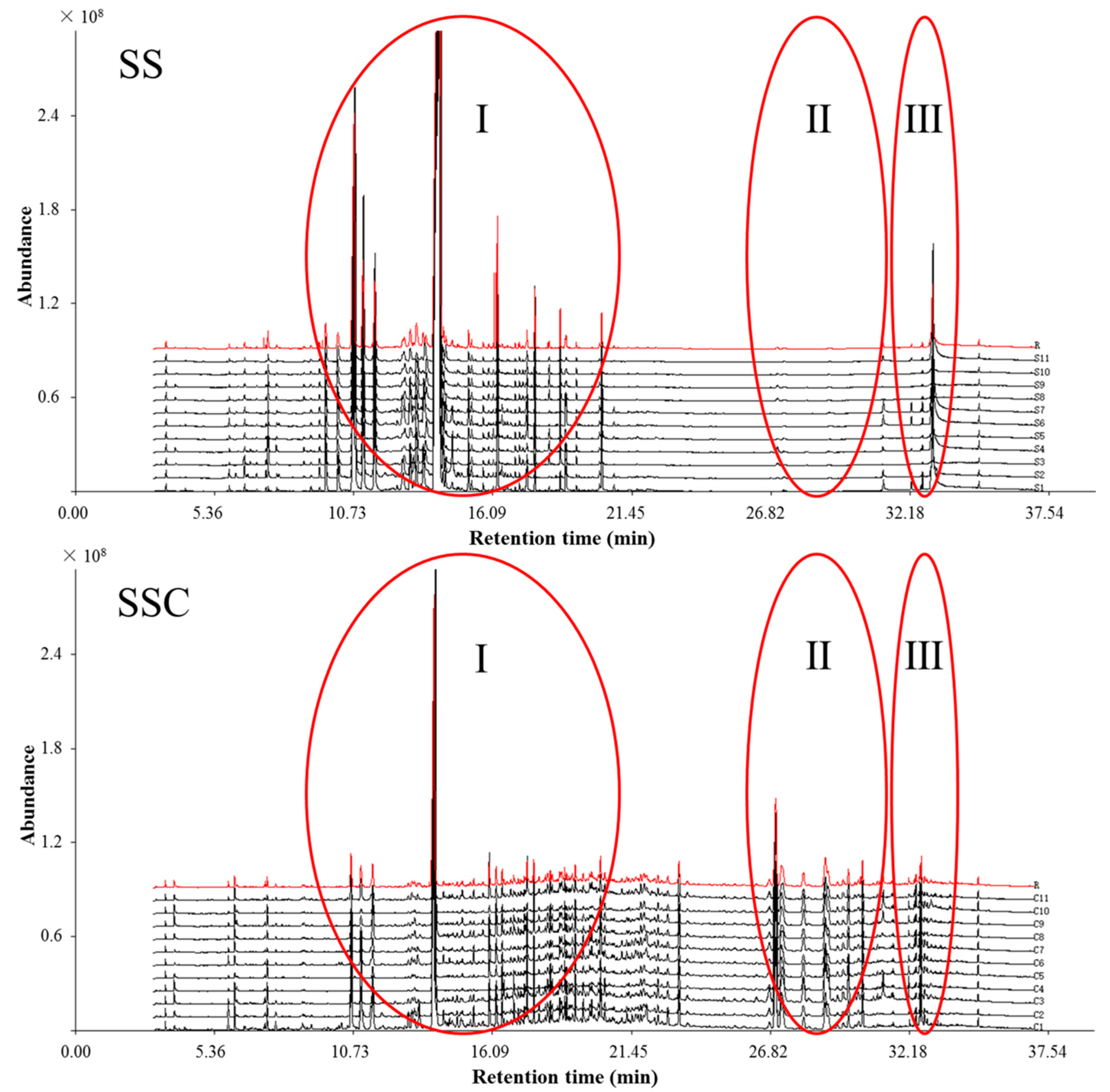
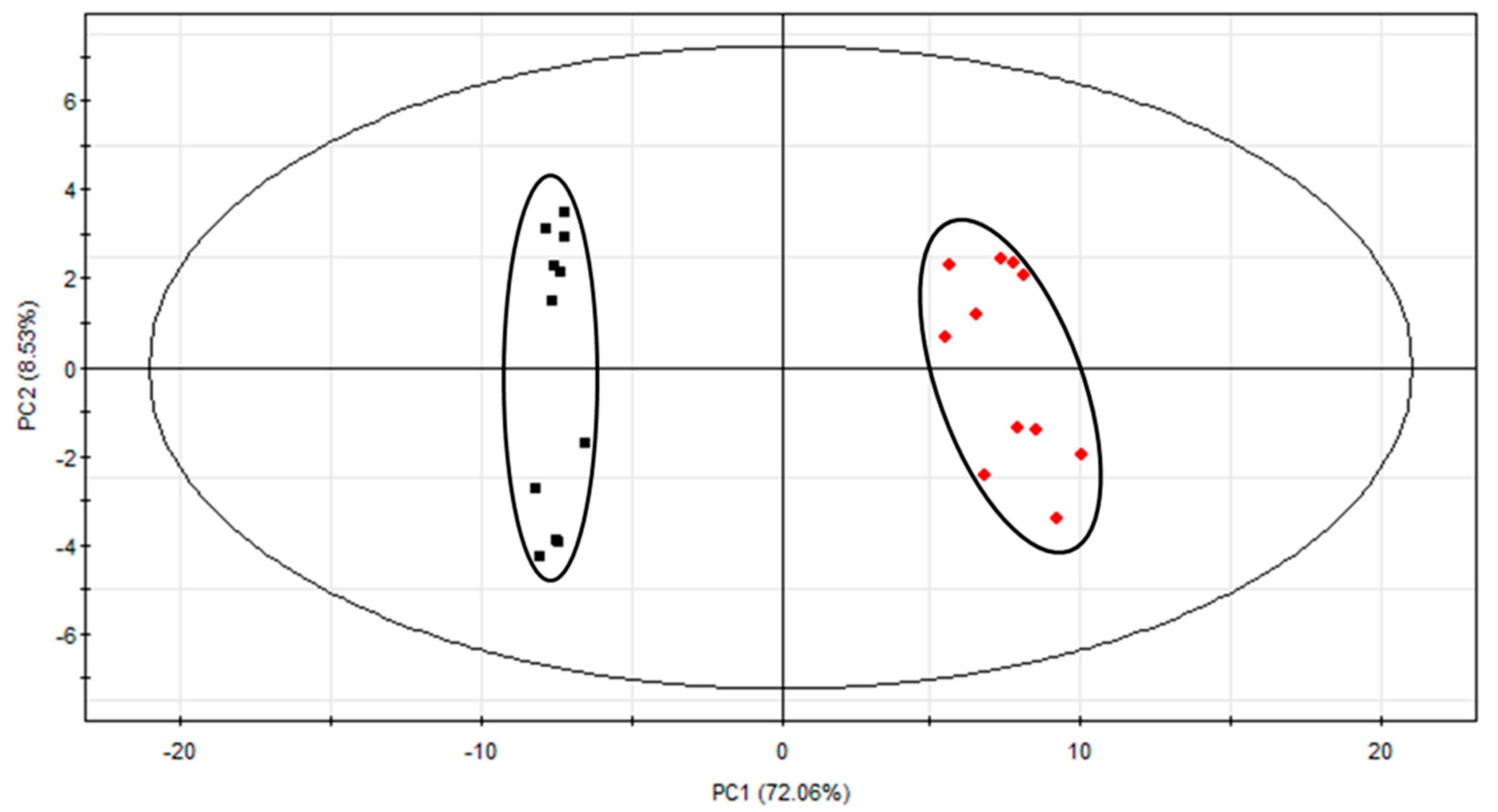
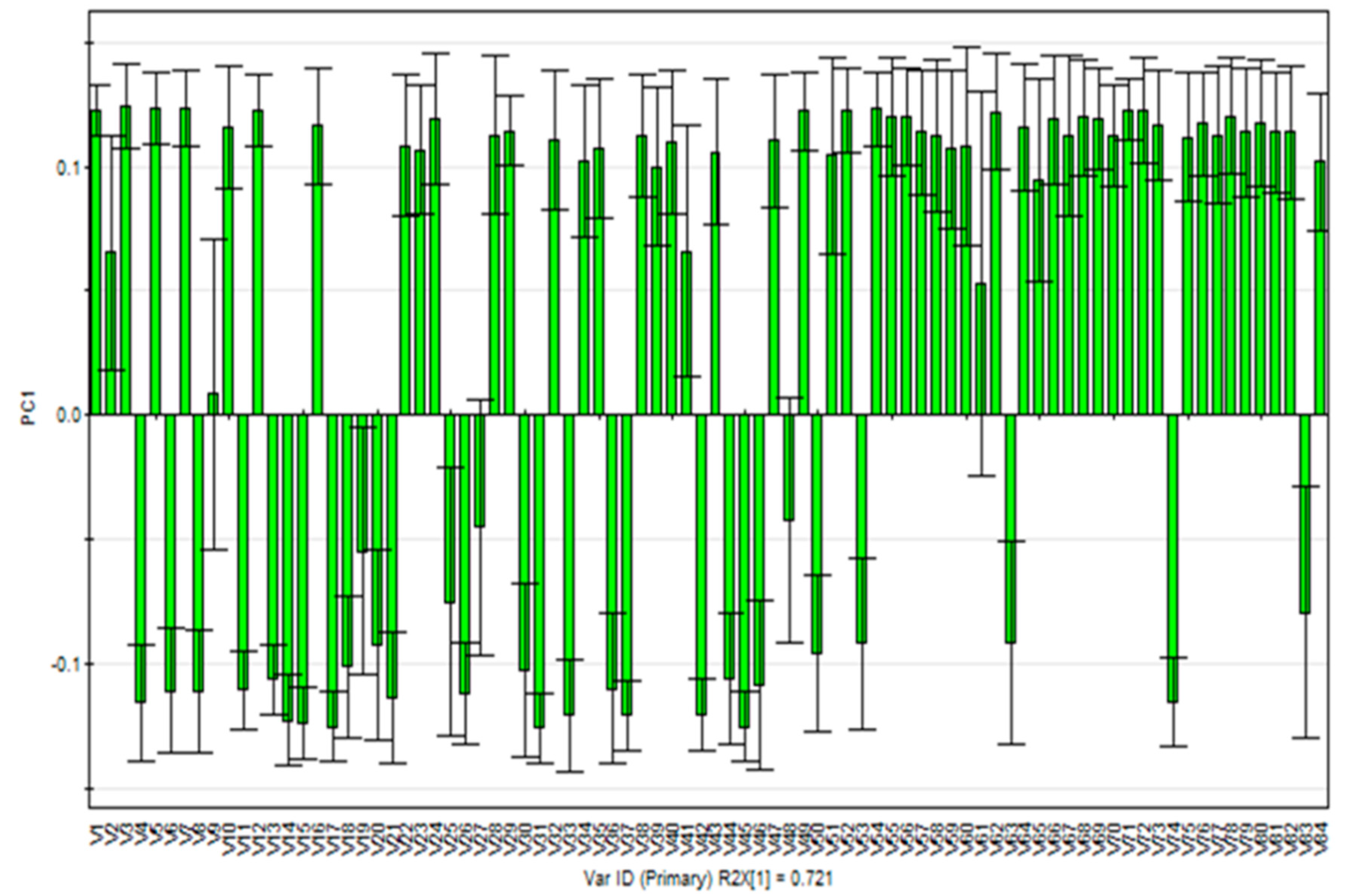
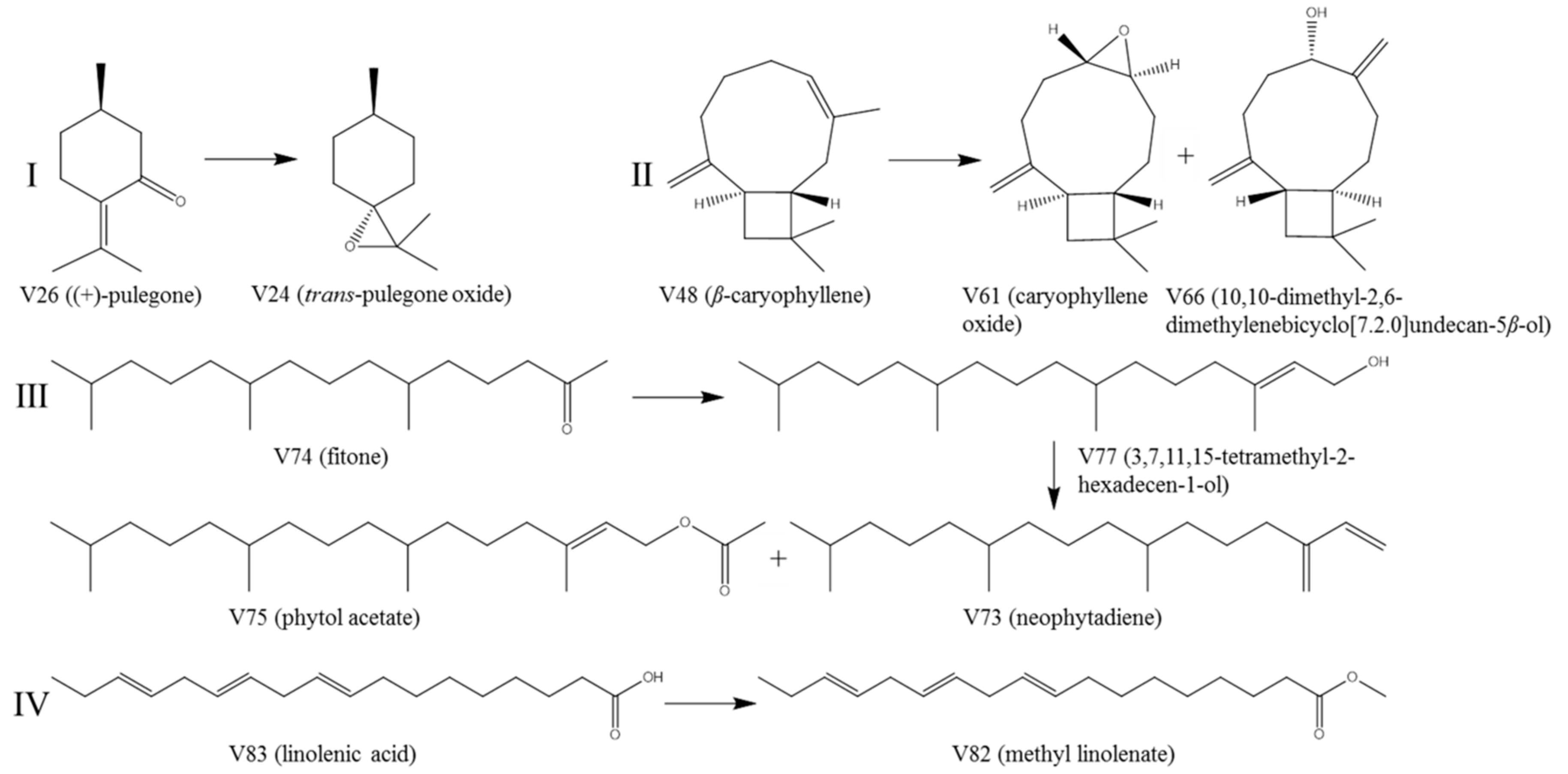
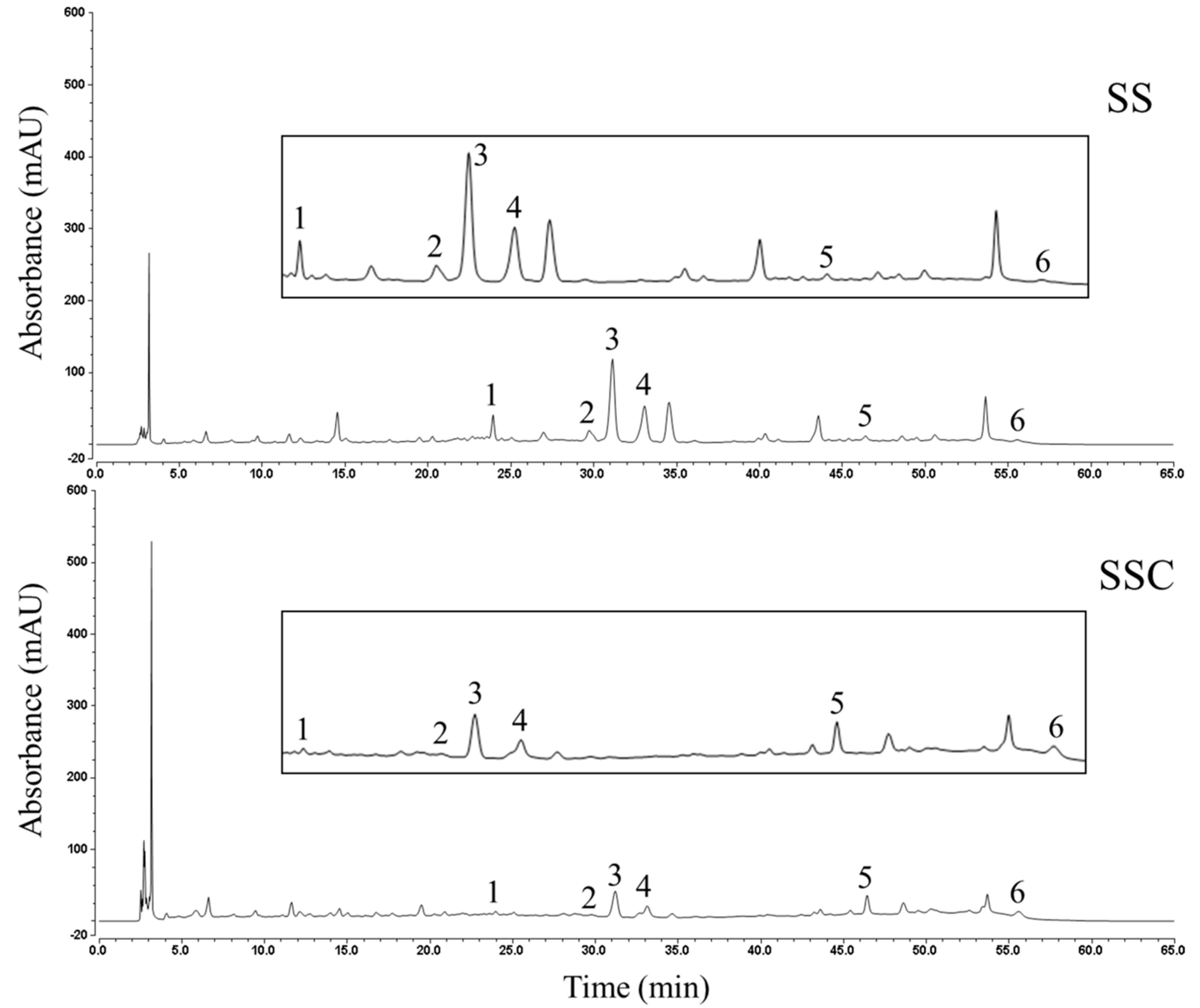
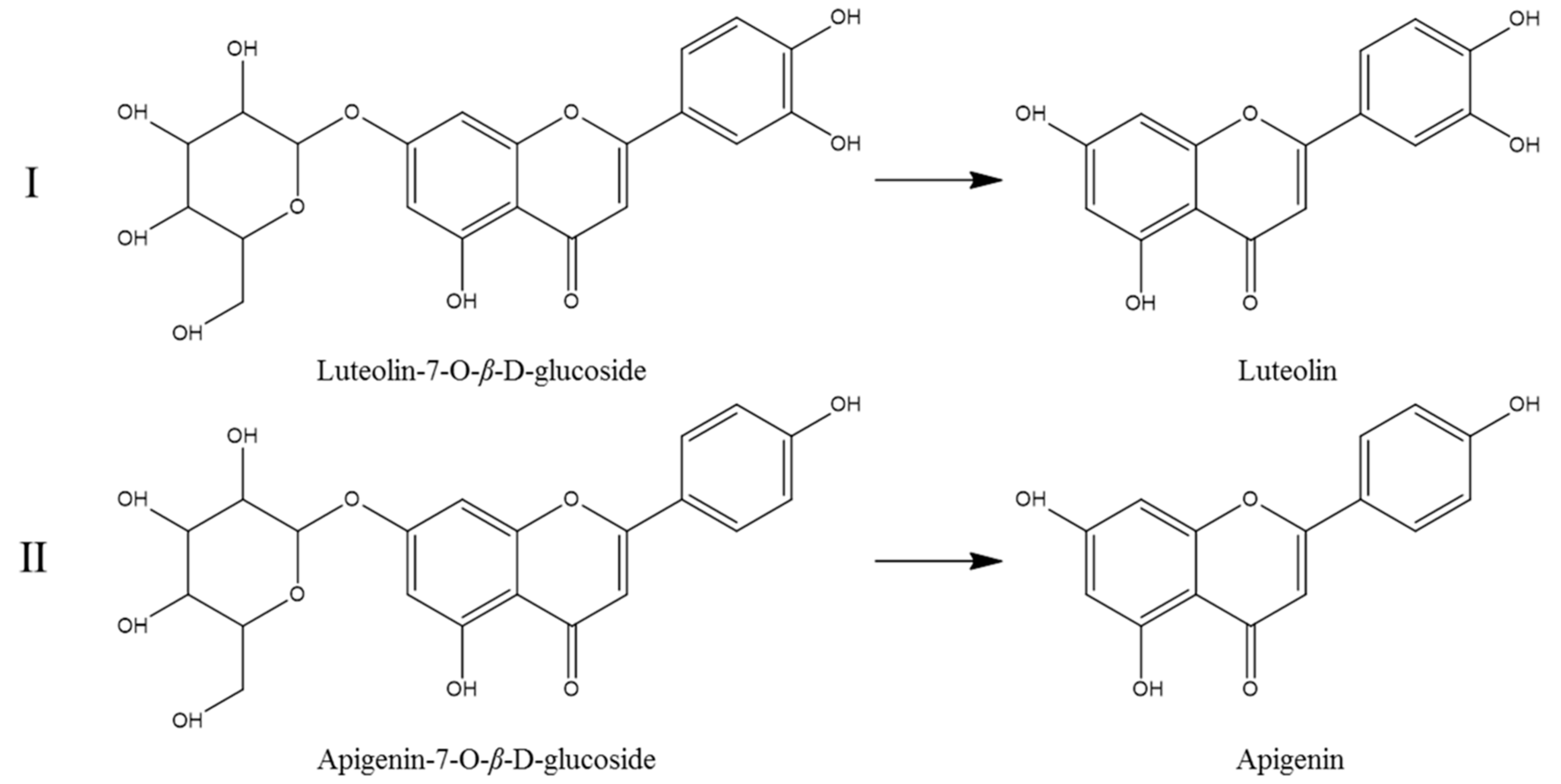
| No. | Voucher Specimen | Place of Collection | Date of Collection | Similarity | |
|---|---|---|---|---|---|
| SS | SSC | ||||
| 1 | YP132581301 | Henan province | 29 November 2018 | 0.982 | 0.974 |
| 2 | YP132581401 | Henan province | 17 January 2019 | 0.969 | 0.995 |
| 3 | YP132581501 | Guangdong province | 8 January 2019 | 0.997 | 0.972 |
| 4 | YP132581601 | Hubei province | 9 January 2019 | 0.995 | 0.962 |
| 5 | YP132581701 | Hubei province | 10 January 2019 | 0.984 | 0.955 |
| 6 | YP132581801 | Shanxi province | 9 January 2019 | 0.990 | 0.989 |
| 7 | YP132580101 | Hebei province | 7 June 2018 | 0.989 | 0.978 |
| 8 | YP132582301 | Hebei province | 9 January 2019 | 0.994 | 0.976 |
| 9 | YP132582601 | Jiangsu province | 11 January 2019 | 0.991 | 0.995 |
| 10 | YP132582901 | Jiangxi province | 11 January 2019 | 0.983 | 0.984 |
| 11 | YP132583001 | Jiangxi province | 12 January 2019 | 0.994 | 0.977 |
| No. | Compound | Molecular Formula | RI | CAS | Similarity Indices | Relative Content (%) | |
|---|---|---|---|---|---|---|---|
| SS | SSC | ||||||
| V1 | Butyl acetate | C6H12O2 | 818.86 | 123-86-4 | 81.07% | - | 0.24 ± 0.06 |
| V2 | (R)-(+)-3-Methylcyclohexanone | C7H12O | 952.53 | 13368-65-5 | 82.43% | 0.10 ± 0.04 | 0.23 ± 0.16 |
| V3 | Benzaldehyde | C7H6O | 965.57 | 100-52-7 | 93.42% | - | 0.52 ± 0.10 |
| V4 | 1-Octen-3-ol | C8H16O | 983.39 | 3391-86-4 | 78.46% | 0.18 ± 0.06 | - |
| V5 | (1R,2S,5S)-2-Methyl-5-(3-oxoprop-1-en-2-yl)cyclopentane-1-carbaldehyde | C10H14O2 | 993.51 | 5951-57-5 | 85.63% | - | 0.07 ± 0.02 |
| V6 | 1,3,8-p-Menthatriene | C10H14 | 1005.59 | 18368-95-1 | 82.08% | 0.04 ± 0.02 | - |
| V7 | 2-Ethyl-1,4-dimethylbenzene | C10H14 | 1022.65 | 1758-88-9 | 91.27% | - | 0.15 ± 0.03 |
| V8 | E,E-2,6-Dimethyl-1,3,5,7-octatetraene | C10H14 | 1023.77 | 460-01-5 | 88.83% | 0.08 ± 0.03 | - |
| V9 | D-Limonene | C10H16 | 1026.40 | 5989-27-5 | 95.44% | 0.38 ± 0.35 | 0.42 ± 0.17 |
| V10 | 3,5-Dimethyl-2-cyclohexen-1-one | C8H12O | 1042.58 | 1123-09-7 | 83.79% | - | 0.15 ± 0.05 |
| V11 | Benzeneacetaldehyde | C8H8O | 1043.37 | 122-78-1 | 91.68% | 0.11 ± 0.05 | - |
| V12 | 1-Ethenyl-3,5-dimethyl-benzene | C10H12 | 1088.07 | 5379-20-4 | 88.24% | - | 0.15 ± 0.04 |
| V13 | 2,5-Dimethylstyrene | C10H12 | 1089.74 | 2039-89-6 | 80.65% | 0.07 ± 0.03 | - |
| V14 | Linalool | C10H18O | 1100.42 | 78-70-6 | 83.43% | 0.10 ± 0.02 | - |
| V15 | trans-1-Methyl-4-(1-methylvinyl)cyclohex-2-en-1-ol | C10H16O | 1118.90 | 7212-40-0 | 89.17% | 0.90 ± 0.17 | - |
| V16 | 1-Phenyl-1-butene | C10H12 | 1122.33 | 824-90-8 | 83.12% | - | 0.06 ± 0.02 |
| V17 | cis-p-Mentha-2,8-dien-1-ol | C10H16O | 1133.26 | 3886-78-0 | 91.38% | 0.81 ± 0.12 | - |
| V18 | l-Menthone | C10H18O | 1148.46 | 14073-97-3 | 90.28% | 13.05 ± 6.27 | 1.84 ± 1.75 |
| V19 | Menthofuran | C10H14O | 1159.04 | 494-90-6 | 81.68% | 3.18 ± 2.34 | 1.46 ± 1.11 |
| V20 | trans-5-Methyl-2-(1-methylvinyl)cyclohexan-1-one | C10H16O | 1171.24 | 29606-79-9 | 88.11% | 2.84 ± 0.61 | 1.75 ± 0.56 |
| V21 | (−)-cis-Isopiperitenol | C10H16O | 1202.38 | 96555-02-1 | 91.15% | 0.73 ± 0.28 | - |
| V22 | 3-Methyl-2-(2-methyl-2-butenyl)-furan | C10H14O | 1208.98 | 15186-51-3 | 86.28% | - | 0.25 ± 0.12 |
| V23 | 4,7-Dimethylbenzofuran | C10H10O | 1214.35 | 28715-26-6 | 84.75% | - | 0.43 ± 0.23 |
| V24 | trans-Pulegone oxide | C10H16O2 | 1218.24 | 13080-28-9 | 79.80% | - | 0.40 ± 0.10 |
| V25 | 2-Allyl-4-methylphenol | C10H12O | 1222.89 | 6628-06-4 | 92.37% | 1.11 ± 0.56 | 0.43 ± 0.37 |
| V26 | (+)-Pulegone | C10H16O | 1245.58 | 89-82-7 | 91.91% | 58.70 ± 11.53 | 27.44 ± 7.85 |
| V27 | Piperitone | C10H16O | 1258.51 | 89-81-6 | 86.72% | 0.35 ± 0.19 | 0.22 ± 0.14 |
| V28 | 5-Isopropenyl-2-methyl-2-cyclohexen-1-yl pivalate | C15H24O2 | 1276.52 | 1000124-59-2 | 79.10% | - | 0.20 ± 0.07 |
| V29 | 4-Ethyl-2-methoxyphenol | C9H12O2 | 1283.03 | 2785-89-9 | 83.34% | - | 0.36 ± 0.14 |
| V30 | (7-Hydroxy-3,3-dimethyl-4-oxo-7-vinylbicyclo [3.2.0]hept-1-yl)acetaldehyde | C13H18O3 | 1290.48 | 1000156-78-3 | 79.14% | 0.40 ± 0.23 | - |
| V31 | (1S,3S,5S)-1-Isopropyl-4-methylenebicyclo[3 .1.0]hexan-3-yl acetate | C12H18O2 | 1294.44 | 139757-62-3 | 83.38% | 0.20 ± 0.03 | - |
| V32 | Thymol | C10H14O | 1297.47 | 89-83-8 | 84.05% | - | 0.30 ± 0.15 |
| V33 | Carveol | C10H16O | 1312.88 | 99-48-9 | 85.39% | 0.13 ± 0.03 | - |
| V34 | (4-Methoxymethoxy-hex-5-ynylidene)-cyclohexane | C14H22O2 | 1315.74 | 1000186-16-6 | 80.43% | - | 0.15 ± 0.08 |
| V35 | 2,5,6-Trimethylbenzimidazole | C10H12N2 | 1328.07 | 3363-56-2 | 88.88% | - | 1.01 ± 0.61 |
| V36 | Carvyl acetate | C12H18O2 | 1335.28 | 97-42-7 | 84.83% | 0.10 ± 0.04 | - |
| V37 | 3-Methyl-6-(1-methylethylidene)cyclohex-2-en-1-one | C10H14O | 1342.11 | 491-09-8 | 90.88% | 3.21 ± 0.55 | 0.84 ± 0.28 |
| V38 | 1,1,5-Trimethyl-1,2-dihydronaphthalene | C13H16 | 1354.07 | 1000357-25-8 | 92.67% | - | 0.61 ± 0.24 |
| V39 | 1,2,3,4-Tetrahydro-1,1,6-trimethylnaphthalene | C13H18 | 1357.25 | 475-03-6 | 83.46% | - | 0.17 ± 0.10 |
| V40 | α-Ethyl-4-methoxybenzenemethanol | C10H14O2 | 1371.02 | 5349-60-0 | 87.85% | - | 0.17 ± 0.08 |
| V41 | α-Copaene | C15H24 | 1376.65 | 1000360-33-0 | 90.42% | 0.11 ± 0.04 | 0.27 ± 0.19 |
| V42 | (−)-β-Bourbonene | C15H24 | 1385.02 | 5208-59-3 | 92.16% | 0.13 ± 0.03 | - |
| V43 | Falcarinol | C17H24O | 1390.30 | 21852-80-2 | 88.33% | - | 0.12 ± 0.06 |
| V44 | β-Elemene | C15H24 | 1393.37 | 515-13-9 | 79.54% | 0.08 ± 0.04 | - |
| V45 | Jasmone | C11H16O | 1399.03 | 488-10-8 | 87.93% | 0.07 ± 0.01 | - |
| V46 | 2-[(2Z)-2-Buten-1-yl]-4-hydroxy-3-methyl-2-cyclopenten-1-one | C10H14O2 | 1401.35 | 17190-74-8 | 85.22% | 0.39 ± 0.18 | - |
| V47 | 1-Methyl-4-[(2-methyl-3-butyn-2-yl)oxy]benzene | C12H14O | 1403.18 | 82719-54-8 | 87.66% | - | 0.90 ± 0.50 |
| V48 | β-Caryophyllene | C15H24 | 1420.14 | 87-44-5 | 94.76% | 1.28 ± 0.78 | 0.89 ± 0.25 |
| V49 | (3β,5α)-2-Methylenecholestan-3-ol | C28H48O | 1455.41 | 22599-96-8 | 80.11% | - | 0.60 ± 0.17 |
| V50 | Humulene | C15H24 | 1458.11 | 6753-98-6 | 86.35% | 0.15 ± 0.10 | - |
| V51 | β-Guaiene | C15H24 | 1479.26 | 88-84-6 | 85.83% | - | 0.11 ± 0.07 |
| V52 | 4-(2,4,4-Trimethyl-cyclohexa-1,5-dienyl)-but-3-en-2-one | C13H18O | 1484.88 | 1000187-51-9 | 84.20% | - | 0.52 ± 0.16 |
| V53 | Germacrene D | C15H24 | 1485.14 | 23986-74-5 | 90.97% | 0.80 ± 0.56 | - |
| V54 | 1-Chlorooctadecane | C18H37Cl | 1496.85 | 3386-33-2 | 84.04% | - | 0.61 ± 0.17 |
| V55 | Bicyclo[4.1.0]heptan-2-ol, 2-Hydroxy-2,6-dimethyl-1-[(1E)-3-methyl-1,3-butadien-1-yl]bicyclo[4.1.0]hept-3-yl acetate | C16H24O3 | 1507.78 | 1000196-25-1 | 83.45% | - | 0.25 ± 0.08 |
| V56 | (+)-δ-Cadinene | C15H24 | 1523.45 | 483-76-1 | 91.52% | 0.13 ± 0.05 | 0.96 ± 0.30 |
| V57 | 4,5,9,10-Dehydroisolongifolene | C15H20 | 1542.96 | 156747-45-4 | 88.25% | - | 0.51 ± 0.25 |
| V58 | 3-(2-Methyl-propenyl)-1H-indene | C13H14 | 1559.02 | 1000187-78-5 | 82.46% | - | 0.53 ± 0.27 |
| V59 | 4,4-Dimethyl-3-(3-methylbut-3-enylidene)-2-methylenebicyclo[4.1.0]heptane | C15H22 | 1563.49 | 79718-83-5 | 82.83% | - | 0.49 ± 0.28 |
| V60 | (−)-Spathulenol | C15H24O | 1579.60 | 77171-55-2 | 81.56% | 0.14 ± 0.04 | 0.48 ± 0.19 |
| V61 | Caryophyllene oxide | C15H24O | 1584.80 | 1139-30-6 | 85.95% | 0.87 ± 0.66 | 1.40 ± 0.66 |
| V62 | Geranyl isovalerate | C15H26O2 | 1595.20 | 109-20-6 | 81.47% | - | 0.56 ± 0.17 |
| V63 | (1R,3E,7E,11R)-1,5,5,8-Tetramethyl-12-oxabicyclo[9.1.0]dodeca-3,7-diene | C15H24O | 1612.71 | 19888-34-7 | 83.83% | 0.06 ± 0.05 | - |
| V64 | (8S)-1-Methyl-4-isopropyl-7,8-dihydroxy-spiro[tricyclo[4.4.0.0(5,9)]-decane-10,2’-oxirane] | C15H24O3 | 1613.74 | 1000193-77-2 | 81.05% | - | 0.15 ± 0.07 |
| V65 | α-Santonin | C15H18O3 | 1628.24 | 481-06-1 | 81.28% | - | 0.19 ± 0.16 |
| V66 | 10,10-Dimethyl-2,6-dimethylenebicyclo-[7.2.0]undecan-5β-ol | C15H24O | 1637.26 | 19431-80-2 | 84.47% | - | 0.29 ± 0.11 |
| V67 | 2-[4-methyl-6-(2,6,6-trimethylcyclohex-1-enyl)hexa-1,3,5-trienyl]cyclohex-1-en-1-carboxaldehyde | C23H32O | 1646.83 | 1000216-09-2 | 79.63% | - | 0.32 ± 0.16 |
| V68 | 13-Heptadecyn-1-ol | C17H32O | 1662.98 | 56554-77-9 | 81.41% | - | 0.58 ± 0.19 |
| V69 | cis-5,8,11,14,17-Eicosapentaenoic acid | C20H30O2 | 1668.82 | 10417-94-4 | 82.21% | - | 0.95 ± 0.29 |
| V70 | (1R,7S,E)-7-Isopropyl-4,10-dimethylenecyclodec-5-enol | C15H24O | 1687.47 | 81968-62-9 | 81.29% | 0.03 ± 0.02 | 0.39 ± 0.15 |
| V71 | 3,4’-Diethyl-1,1’-biphenyl | C16H18 | 1708.74 | 61141-66-0 | 88.07% | - | 0.45 ± 0.09 |
| V72 | 3,7,11-Trimethyl-1-dodecanol | C15H32O | 1723.32 | 6750-34-1 | 80.42% | - | 1.49 ± 0.38 |
| V73 | Neophytadiene | C20H38 | 1834.08 | 504-96-1 | 90.35% | - | 10.11 ± 3.20 |
| V74 | Fitone | C18H36O | 1842.16 | 502-69-2 | 87.33% | 0.05 ± 0.02 | - |
| V75 | Phytol acetate | C22H42O2 | 1860.42 | 1000375-01-4 | 85.59% | - | 1.58 ± 0.60 |
| V76 | 2,4,7,14-Tetramethyl-4-vinyl-tricyclo[5.4.3.0(1,8)]tetradecan-6-ol | C20H34O | 1865.55 | 1000193-31-2 | 84.74% | - | 0.26 ± 0.09 |
| V77 | 3,7,11,15-Tetramethyl-2-hexadecen-1-ol | C20H40O | 1879.81 | 102608-53-7 | 85.05% | - | 3.95 ± 1.53 |
| V78 | Hexadecanenitrile | C16H31N | 1895.78 | 629-79-8 | 81.46% | - | 0.63 ± 0.19 |
| V79 | 1-Heptatriacotanol | C37H76O | 1914.84 | 105794-58-9 | 81.06% | - | 0.21 ± 0.08 |
| V80 | Methyl palmitate | C17H34O2 | 1931.28 | 112-39-0 | 88.36% | - | 1.56 ± 0.48 |
| V81 | Methyl linoleate | C19H34O2 | 2091.82 | 112-63-0 | 92.97% | - | 0.70 ± 0.26 |
| V82 | Methyl linolenate | C19H32O2 | 2097.76 | 301-00-8 | 90.66% | 0.08 ± 0.06 | 1.28 ± 0.45 |
| V83 | Linolenic acid | C18H30O2 | 2149.50 | 463-40-1 | 94.44% | 2.67 ± 2.41 | - |
| V84 | 2,2’-Methylenebis(6-tert-butyl-4-methylphenol) | C23H32O2 | 2428.07 | 119-47-1 | 87.78% | 0.11 ± 0.02 | 0.28 ± 0.10 |
| Contents of Nonvolatile Compounds (mg/g) | |||||||
|---|---|---|---|---|---|---|---|
| Luteolin-7-O-β-d-glucoside | Apigenin-7-O-β-d-glucoside | Hesperidin | Rosmarinic Acid | Luteolin | Apigenin | Total | |
| SS | 0.40 ± 0.06 | 0.25 ± 0.09 | 2.97 ± 0.99 | 1.62 ± 0.67 | 0.04 ± 0.04 | 0.01 ± 0.01 | 5.29 ± 0.42 |
| SSC | 0.05 ± 0.01 *** | 0.02 ± 0.01 *** | 0.64 ± 0.16 *** | 0.40 ± 0.11 *** | 0.32 ± 0.05 *** | 0.13 ± 0.03 *** | 1.56 ± 0.06 *** |
© 2020 by the authors. Licensee MDPI, Basel, Switzerland. This article is an open access article distributed under the terms and conditions of the Creative Commons Attribution (CC BY) license (http://creativecommons.org/licenses/by/4.0/).
Share and Cite
Liu, X.; Zhang, Y.; Wu, M.; Ma, Z.; Cao, H. The Potential Transformation Mechanisms of the Marker Components of Schizonepetae Spica and Its Charred Product. Molecules 2020, 25, 3749. https://doi.org/10.3390/molecules25163749
Liu X, Zhang Y, Wu M, Ma Z, Cao H. The Potential Transformation Mechanisms of the Marker Components of Schizonepetae Spica and Its Charred Product. Molecules. 2020; 25(16):3749. https://doi.org/10.3390/molecules25163749
Chicago/Turabian StyleLiu, Xindan, Ying Zhang, Menghua Wu, Zhiguo Ma, and Hui Cao. 2020. "The Potential Transformation Mechanisms of the Marker Components of Schizonepetae Spica and Its Charred Product" Molecules 25, no. 16: 3749. https://doi.org/10.3390/molecules25163749
APA StyleLiu, X., Zhang, Y., Wu, M., Ma, Z., & Cao, H. (2020). The Potential Transformation Mechanisms of the Marker Components of Schizonepetae Spica and Its Charred Product. Molecules, 25(16), 3749. https://doi.org/10.3390/molecules25163749






